Susan Alexander and I will be reading at Christ Church Cathedral, downtown Vancouver, on Saturday October 22, from 4-5pm. All are welcome!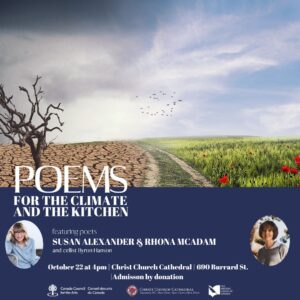
The poster was so beautiful I had to share!
Susan Alexander and I will be reading at Christ Church Cathedral, downtown Vancouver, on Saturday October 22, from 4-5pm. All are welcome!
The poster was so beautiful I had to share!
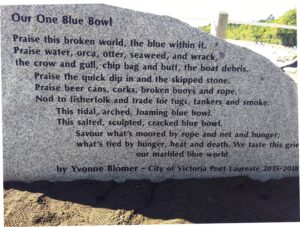 A sunny Sunday on Dallas Road – we gathered to watch the unveiling of the latest Victoria poet laureate legacy art installation. This was a poem by Yvonne Blomer whose term ended in 2018. It’s perched on a grassy spot on Dallas Road, overlooking the ocean.
A sunny Sunday on Dallas Road – we gathered to watch the unveiling of the latest Victoria poet laureate legacy art installation. This was a poem by Yvonne Blomer whose term ended in 2018. It’s perched on a grassy spot on Dallas Road, overlooking the ocean.
The big reveal: Yvonne introduces the project and then cuts the ribbon and enlists the help of her husband and father to unwrap her poem.
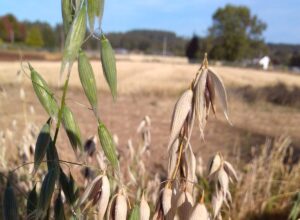 Saturday was a beautiful day for a farm party and tour of the facilities at Field 5 Farm, where Farm Folk City Folk was also showing off a new mobile seed cleaner. Farm and city folk gathered to sample some local whiskey and beer made from Field 5 malts, enjoy some music and learn a bit more about local grains and watch some seed cleaning demos.
Saturday was a beautiful day for a farm party and tour of the facilities at Field 5 Farm, where Farm Folk City Folk was also showing off a new mobile seed cleaner. Farm and city folk gathered to sample some local whiskey and beer made from Field 5 malts, enjoy some music and learn a bit more about local grains and watch some seed cleaning demos.
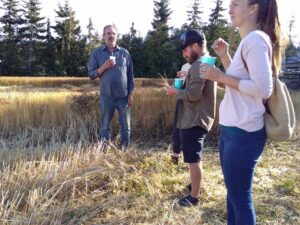 Mike Doehnel, last seen at a Kneading Conference some years ago in Mount Vernon, is now farming with Field 5 and gave some info about what’s being grown and the challenges of harvesting small scale for different purposes. Two different flax plots growing, one for a cover crop and the other for the very flax farmer I’d seen (during last month’s North Saanich Flavour Trail at Sandown), whose interest is in producing local linen. Photo above shows black oats, and here Mike talks about khorasan wheat, an ancient grain.
Mike Doehnel, last seen at a Kneading Conference some years ago in Mount Vernon, is now farming with Field 5 and gave some info about what’s being grown and the challenges of harvesting small scale for different purposes. Two different flax plots growing, one for a cover crop and the other for the very flax farmer I’d seen (during last month’s North Saanich Flavour Trail at Sandown), whose interest is in producing local linen. Photo above shows black oats, and here Mike talks about khorasan wheat, an ancient grain.
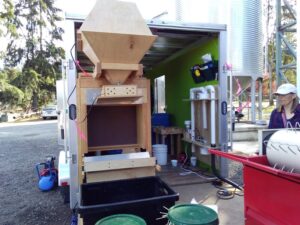 Lisa Willot (FFCF‘s Vancouver Island Seed Security Program Coordinator)checks on the equipment in the mobile seed cleaner, which she’ll be taking on the road soon. It will allow small scale producers to save more local seed. Which improves local food security by allowing farmers to plant more locally produced crops adapted to changing climactic conditions.
Lisa Willot (FFCF‘s Vancouver Island Seed Security Program Coordinator)checks on the equipment in the mobile seed cleaner, which she’ll be taking on the road soon. It will allow small scale producers to save more local seed. Which improves local food security by allowing farmers to plant more locally produced crops adapted to changing climactic conditions.
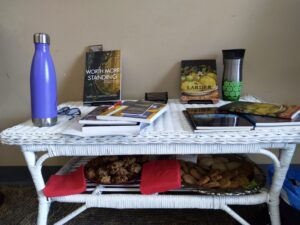 I was delighted to have a chance to read with local (Surrey BC) poet and civic treasure Heidi Greco, a fellow foodie and activist in all good causes. We decided to celebrate National Organic Week with a poetry conversation at White Rock Public Library on September 17.
I was delighted to have a chance to read with local (Surrey BC) poet and civic treasure Heidi Greco, a fellow foodie and activist in all good causes. We decided to celebrate National Organic Week with a poetry conversation at White Rock Public Library on September 17.
Our poetry extended into a bit of baking, and we provided cookies as a reward to our delightful audience.
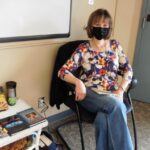
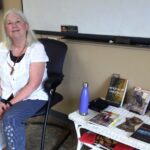 We made it a poetry conversation, alternating poems and thoughts on trees, food and matters ecological. Was busy reading and talking so not much time for photos, but here we were beforehand!
We made it a poetry conversation, alternating poems and thoughts on trees, food and matters ecological. Was busy reading and talking so not much time for photos, but here we were beforehand!
I learned the important connection between food and sewage years ago when I came across the excellent documentary Crapshoot: The Gamble with Our Wastes. The film of course talked also about garbage disposal and the endless growth of landfill waste which humans create so easily and dispose of so badly.
So I was pleased to finally be able to catch a Hartland Landfill tour, which I’d heard was well worth taking. So much has already been written and said about the growth of food waste in well-fed nations I won’t belabour the point here; but just to say it seems we are not willing or able to manage the food we buy, grow or manufacture, and despite composting pick-up systems now in place, too much of it still finds its way to places like Hartland, where it generates greenhouse gases.
So one of the features that most intrigued me was the methane capture system – basically a series of pipes laid into and across the ever growing garbage mountain, feeding into an electricity plant – which powers (so far) about 1600 homes in the area, with plans for expansion. However, as long as food waste – the primary source of this methane – can be diverted into composting programs, the growth will slow.
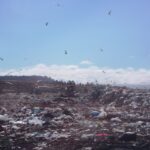 Our tour bus spent time sitting at the top of the current garbage mountain, so we could watch birds scavenging and scattering. Our guide told us that birds of prey (from the Cowichan Raptor Centre) come to keep order later in the year, and this program of Natural Predation is by far the most effective preventive measure they have found. The birds who feed on our garbage end up the worse for it because of consuming microplastics and toxins.
Our tour bus spent time sitting at the top of the current garbage mountain, so we could watch birds scavenging and scattering. Our guide told us that birds of prey (from the Cowichan Raptor Centre) come to keep order later in the year, and this program of Natural Predation is by far the most effective preventive measure they have found. The birds who feed on our garbage end up the worse for it because of consuming microplastics and toxins.
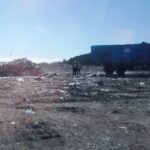 I was also encouraged to see inspectors checking each load that was deposited by garbage trucks. Because space is limited by planetary constraints, our municipalities have strict guidelines about garbage vs recyclables and compostables; the guidelines are enforced through fining the trucks that pick up our bins. A 2016 study of Hartland found that organics, paper and plastics made up half of what is thrown away by locals; hence our blue and green bin pick-up programs.
I was also encouraged to see inspectors checking each load that was deposited by garbage trucks. Because space is limited by planetary constraints, our municipalities have strict guidelines about garbage vs recyclables and compostables; the guidelines are enforced through fining the trucks that pick up our bins. A 2016 study of Hartland found that organics, paper and plastics made up half of what is thrown away by locals; hence our blue and green bin pick-up programs.
Even so, unless consumers and businesses change their ways by reducing their annual waste load of 400kg/person to 125kg, Hartland expects to run out of space by 2045. At this point the waste will be destined to take over some of the local hiking and bike trails on a neighbouring mountain.
Adjoining the current mountain is a new valley being excavated ready to fill; in the background are sea, sky and mountains. And here’s what the power station looks like. There’s a nearby leachate pond as well, which is toxic fluid runoff, contaminated by
The landfill site is also a busy recycling centre, trying to reclaim as much as possible from consumer waste – people can bring in plastics, metal, clothing, paint etc to a public drop-off area, and the centre distributes and sorts it for whatever further life it might have. There’s composting available for larger scale drops, for a fee.
Here’s a closing thought: one of the items that has been deemed not recyclable is a damaged blue box!